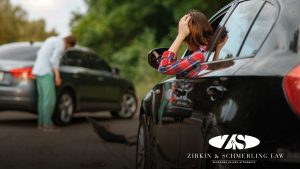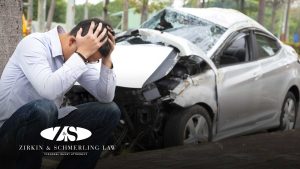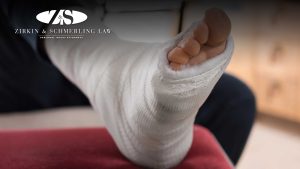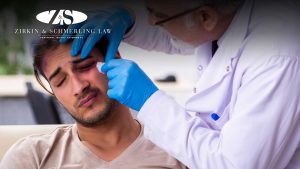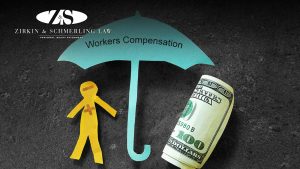Rollover accidents are exactly what they sound like, car crashes where a vehicle is flipped over and rolls horizontally, or in rare cases, end to end. The vehicle may roll halfway, landing on its roof, all the way, landing upright again; it may even make several revolutions. As you can imagine, this is a particularly terrifying experience that can result in severe injuries or even fatalities. Drivers and passengers risk being crushed or trapped as the roof and chassis of their vehicle collapse on them. They also risk being ejected from the vehicle entirely. If you have been involved in a accident the Maryland Rollover Accident Lawyers at Zirkin & Schmerling can help you get the compensation you deserve.
Rollover Statistics:
- Rollover accidents are relatively rare, compared to other types of accidents (2.1% of the total in 2010), but when they do happen, they are particularly dangerous. They accounted for almost 30% of all motor vehicle accident fatalities in 2019, according to the Insurance Institute of Highway Safety.
- In 2019, there were 6,358 fatalities as a result of rollover accidents.
- Not all rollovers occur as a result of a collision with another vehicle or fixed obstacle; in fact, only 74% of them do.
- The other 26% of rollovers are caused by “tripping” on an obstacle or by making sharp turns and overcompensating for that.
- The obstacle could be something as innocuous as a pothole, roadside shoulder, curb, or even soft dirt, but when the vehicle “trips” on it, the center of gravity is thrown off.
- Consumer Reports cited the government as saying that 95% of rollovers were the result of vehicle “trips,” but also allows that that percentage may be too high.
- Another way taller vehicles can roll over is when the driver makes a sudden turn to the right or left, and then sharply overcorrects. This can set up a kind of pendulum effect that eventually topples the vehicle.
- Only 2% of rollover accidents are end-to-end flips.
- Although in certain circumstances, any vehicle can flip, it is far more likely for taller vehicles to be involved in rollover accidents. SUVs, vans, and pick-ups all have higher centers of gravity than cars and are more top-heavy.
- Most rollover accidents (75%) occur on rural roads where there are no dividers, but the speed limit is 55 mph.
In 2019:
- 2,792 rollover fatalities (44%) occurred in accidents caused by frontal impacts.
- 1,637 rollover fatalities (26%) occurred in accidents with no impact (tripping, driver’s overcorrection, tire malfunction, etc…)
- 976 rollover fatalities (15%) occurred in accidents caused by side impacts.
- 673 rollover fatalities (11%) occurred in accidents with unknown or “other” causes.
- 280 rollover fatalities (4%) occurred in accidents caused by rear impacts.
Factors in Maryland Rollover Accidents:
- Speed: This is a factor in many accidents. For example, 3,027 accidents in Maryland in 2020 listed speeding as a factor.
- Alcohol: A total of 2,673 motor vehicle accidents in Maryland in 2020 were attributed to alcohol or drug-impaired driving. According to the NHTSA, more than 25% of all MVCs are the direct result of alcohol impairment.
- Poor road conditions: Not all roads in Maryland are as well maintained as they should be, so “tripping” accidents can be caused by potholes, gravel, or sift shoulders.
- Aggressive driving: 2,962 Maryland crashes were blamed on aggressive driving in 2020.
- Distracted driving: Maryland had 45,378 accidents attributed to distracted driving in 2020. That number includes crashes specifically caused by cell phone distractions.
- Tire blowouts: According to the NHTSA, there were 738 fatalities caused by blown tires in the United States. A blown tire can result in a rollover accident if the driver loses control of a vehicle with a high center of gravity.
- Defective suspension systems: Vehicles with high centers of gravity can easily lose contact with the ground while traveling around a curve if the suspension system malfunctions. This can lead to rollover accidents.
SUVs Most Likely to Rollover (according to Hot Cars):
- 2017 Nissan Nv3500
- 2011 Honda Element
- 2012 Dodge Nitro
- 2013 Hyundai Accent
- 2016 GMC Yukon
- 2017 Toyota 4Runner
- 2017 Jeep Wrangler Unlimited
- 2016 Jeep Renegade
- 2016 Chevrolet Tahoe
- 2017 Cadillac Escalade
Safety Measures:
All is not doom and gloom on the automotive front; every year more and more safety protective devices are becoming standard. Not only are vehicles less likely to roll over than they have been, but if they do roll over, the occupants are more likely to survive the crash.
- Electronic Stability Control: This causes individual tires to brake automatically so that they steer in the direction you want. It has been a requirement in all passenger vehicles manufactured since 2012.
- Rollover activated side curtain airbags: These reduce fatalities in single-vehicle rollover crashes by 23% for drivers and passengers in the front of the vehicle who are wearing seatbelts correctly. They reduce fatalities by 20% for belted occupants of the back seat.
- Variable Ride Height Suspension Systems: With these, vehicles can ride higher when they need to be off-road and lower on highways, lowering their high center of gravity.
- Stronger roofs: The NHTSA increased their strength to weight rating for roofs, since many rollover crashes can be survivable if the roof doesn’t crush the occupants.
Safest 2021 SUVs, according to IIHS crash test ranking reported in Forbes)
Small SUVs:
- 2021 Mazda CX-5
- Mazda CX-30 (built after September 2020)
- Mazda CX-5
- Nissan Rogue
- Subaru Forester
Midsize SUVs:
- Ford Explorer
- Hyundai Palisade
- Mazda CX-9
- Nissan Murano
- Subaru Ascent
Safety Tips for You:
- Don’t overload your vehicle to make it top-heavy.
- Always use all safety restraints correctly.
- Follow speed limits, and be particularly careful approaching curves or corners.
- If the vehicle begins to tilt, steer towards the tilt.
- If the vehicle rolls, don’t brace yourself against the steering wheel; instead, grab your opposite shoulders to keep your head and neck in alignment.
- If you land upside down, turn off the engine, brace yourself against the roof, and unbuckle your seat belt.
- Call 911.
Typical Injuries in Maryland Rollover Accidents:
- Head injuries: it stands to reason that if your head makes contact with the roof as it is being crushed down, it will be injured. Traumatic brain injuries can result from rollover accidents.
- Neck Injuries: When your head is snapped back and forth in a violent revolution (or two), it can damage the ligaments, nerves, and muscles in your neck.
- Spine injuries: As in any serious crash, discs in the spine can be damaged in a rollover accident. The spinal cord may even be affected, which could lead to paralysis.
- Upper body injuries: These can include rib injuries or collapsed lungs.
- Fractures: If your body is thrown around the vehicle or if you are ejected from the vehicle, you may break bones, especially in your limbs or pelvis. In some cases, amputations can occur.
- Internal organ damage or bleeding: Kidneys, livers, and spleens are the organs most often damaged in MVCs.
- Scarring and disfigurement: Not only can disfigurement cause physical pain, but it can also cause deep emotional pain that lasts.
- Emotional and Psychological Injuries: Motor vehicle accidents are the leading cause of PTSD.
Recent Maryland Rollover Accidents:
- February 25, 2022: A 33-year-old man driving south on Kenilworth Avenue in Cheverly, Prince George County lost control of his vehicle, rolled over, went off the road, and hit another vehicle. One driver was pronounced dead at the scene, and the other was critically injured.
- February 12, 2022: A driver rolled over while on the exit ramp of Westbound Interstate 70 leading to Westbound US 40 near Hagerstown. In the rollover, the driver was ejected from the vehicle and was pronounced dead at the scene.
- January 24, 2022: A 39-year-old driver lost control of his 2002 Volkswagon Golf GTI on Southbound Interstate 83 in Baltimore County. His car flipped several times in the center median. He was pronounced dead at the hospital.
- February 20, 2022: A 15-year-old female passenger died on I-68 in Cumberland after being ejected from a 2000 GMC Yukon when the driver lost control of the vehicle. The SUV hit a guardrail and rolled over.
What Now?
If you have been injured in a rollover accident, you will be facing an onslaught of medical bills and financial demands while you are also recovering from a traumatic experience that may have left you with serious or even permanent injuries. Whether the crash occurred as a result of another driver, a municipality, or a faulty piece of equipment, you need to be compensated in order to move forward.
You may be compensated for:
- Medical expenses:
Maryland uses the collateral source rule to allow plaintiffs who have been injured in auto accidents to recover damages for medical expenses, even if health insurance covers them. If you have been injured, you may be able to recover damages for past and future medical expenses that can be attributed to the incident.
Those who have been seriously injured often require more than surgery or hospitalization to fully recover. Medical expenses can also include rehabilitation and physical therapy, psychological treatment, and assistive devices like walkers, canes, and wheelchairs.
- Lost Income
Serious injuries can mean weeks or months away from work while you heal. In fact, some people who have been seriously injured find themselves unable to work at the same level again. You may be able to recover past and future lost wages by filing a lawsuit.
- Pain & Suffering
After an accident, the pain and suffering you experience can seep into every aspect of your life. Pursue compensation for your physical and mental suffering, so you have the resources you need to move forward with your life.
- Property Damage
In an auto accident, the primary property damage is to the vehicles. You may be able to recover the cost of your vehicle, and possibly other property that was destroyed inside the vehicle at the time of the collision.
In certain tragic circumstances, victims of a car accident may file a wrongful death or survival action under auto accident law in Maryland. Wrongful death cases are brought on behalf of a deceased victim’s beneficiaries, such as spouses, children, or parents.
A survival action can be brought by the estate of an individual who has died in a car accident. In this instance, the estate steps in for the deceased individual and sues for damages like medical bills, pain and suffering. You can find more information about what your auto accident might be worth by reading our in-depth article on the topic.
Contact a reputable and experienced Maryland Rollover Accident Lawyer:
The Maryland Rollover Accident Lawyers at Zirkin & Schmerling Law are experienced in dealing with the aftermath of rollover accidents. The crash may have been the fault of:
- Another driver
- A town, county, or the state of Maryland (road conditions)
- A vehicle or equipment manufacturer
We will get to the bottom of it and take the appropriate steps. For example, if another driver caused the accident, he or she may have been speeding, distracted, or driving under the influence. We can gather evidence to hold the negligent driver responsible. Having excellent legal representation is also extremely important. It’s very difficult to handle an accident case alone while you’re already struggling to rest and recover from your injuries.
Your lawyer relieves your huge burden of legal work and ensures your case is handled professionally, giving you the best possible chance at a positive outcome. Insurance companies are notoriously loath to part with money, but Zirkin & Schmerling Law Firm has a proven track record of negotiating settlements. If the insurance company refuses to settle for a fair amount, we can file a civil lawsuit against the at-fault party.
Statute of Limitations
In Maryland, you have 3 years from the date of the accident to file a lawsuit. This is laid out in Statute: §5–101:
A civil action at law shall be filed within three years from the date it accrues unless another provision of the Code provides a different period of time within which an action shall be commenced.
However, it is always best to consult an attorney as soon as possible.
Get a free case consultation today. Call 410-753-4611. Or contact us online.



